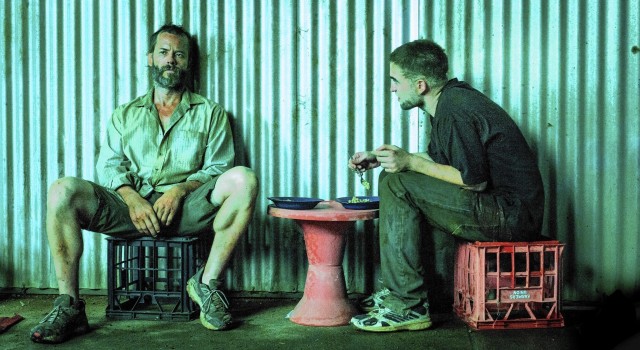
The Rover (2014) features a coolly desaturated palette of arid browns, sickly sodium-light greens and blanched flesh tones.
I was a farmer and now I am here.
Eric (Guy Pearce) to Reynolds (Robert Pattinson) in answer to a question about his occupation.
Not everything has to be about soming.
Reynolds responding to Eric’s inquiry as to why he has chosen to share a memory with him.
A threat means there’s still something left to happen.
Eric’s response to a Soldier’s (Anthony Hayes) remark about being threatened.
The Rover is an enticing addition to Australia’s ‘weird’ cinema traditions, directed with some confidence by David Michod, whose last film was the critically-lauded Animal Kingdom. It is essentially a post-apocalyptic revenge movie set, as a brief screen note cryptically confirms, “Ten years after the collapse”. There is also a liberal helping of Southern Gothic at work, as evidenced by Robert Pattinson’s striking turn as a retarded American criminal lost in the Australian outback. Michod’s sense of direction is so assured that the film manages to subtly background its own lack of narrative by making it comparable to the lack of meaning to be found in this nightmarish near-future. The metatextuality carries on in sequences such as when Pattinson’s Reynolds listens to a pop song about being beautiful and successful – things that the actor is all too aware of from his early Twilight franchise success. This is a wild west Australia, where life is grim, brutish and invariably short. It is hard to think of any other recent film in which human life has been dispatched with such atrocious immediacy. Perhaps, the closest comparable work might be John Boorman’s hitman death dream Point Blank (1967), another film that uses intense sunlight and a coolly desaturated palette to create a cinematic ‘otherness’ to a landscape.
The film’s plot is unbearably slight. However, this masks a quietly effective realisation of a future landscape where American dollars are everything, Asian communities seem to predominate, food is scarce, security even scarcer and recognisable humanity the rarest commodity of all. Guy Pearce’s Eric is the central figure in this wasteland. Introduced as a drifter in possession of a car, it is through the theft of this vehicle by Henry (Scoot McNairy) and his band of multi-ethnic criminals, that the film jump-starts its narrative. From the moment the car is stolen Eric is in pursuit of the criminals. A degree of crazed hopelessness seems to mark Eric out as a particularly dangerous individual. When Henry’s crew choose not to kill Eric early on in the film, the stage is effectively set for a final act of bloody vengeance.
Pearce plays this laconic role with an air of fatalism hanging constantly over his character. Seething with incomprehensible rage against the state of humanity, and perhaps his own soul, Pearce’s dogged pursuit plays out like a gnomic act of redemption. Reynolds somehow insinuates himself into what is left of Eric’s affections. As Henry’s younger brother, Reynolds has been left behind at the scene of a shoot-out with the police. Seemingly the rest of Henry’s crew have given Reynolds up for dead, but Henry feels some remorse for leaving his kid brother behind. Pattinson’s rendering of this difficult character makes for an intriguingly modern interpretation of the Dostoevskian innocent fool, in the Myshkin mode. Reynolds is all stutter and overbite, vacillating between blank incomprehension and garbled mysticism. Ultimately, it is Reynolds who rekindles a slight flame of fellow feeling in Eric, only to snuff that out at the film’s close.
It is Henry’s perceived act of desertion, by leaving his brother at the scene of a bloody crime, that brings about the vendetta logic of the closing shootout. At this moment Eric seems to become the wrathful exacting agent of sibling betrayal, the violent means through which Reynolds will confront and kill his brother. In the demented bushlands and arid tundra of this near lawless future Australia revenge is very much a contagion. There are at least three sources for this disease in the film, all of them converging upon Eric: the military police, the criminal crew and a nameless assailant.
The film’s aesthetics and narrative concerns are very much those of an earlier period of US cinema, from the late-1960s and early-1970s. Two more touchstone films would be the Clint Eastwood double-header of The Beguiled (1971) and High Planes Drifter (1973). Both of these films feature wounds, a Southern Gothic ambience, drifters and deferred vengeance. Whereas both of those films had a fever dream of haunting eroticism and powerful sexuality at their core, The Rover never lets such a clamorous and hysterical atmosphere be fully felt. It is a film almost entirely devoid of the sexual impulse and all the more chilling and detached for it. When the sexual does find some form of expression it is as deformed and warped as the society that it inhabits.
What is highly impressive throughout the film is the manner in which Eric’s humanity incongruously pierce’s through the taut and angular features of Pearce’s face, particularly at moments when they are riven with hatred and loathing. Pearce’s performance in close-up is as good as he has yet realised on screen, with so much being conveyed by the slightest shift in muscle tension. Michod’s measured direction helps to maintain the ambiguity of these expressions, showing an innate confidence in both his material and how his audience will be able to make sense of it. Once again Australian cinema embraces the hauntingly primeval and compromised qualities of the country’s landscape, creating a tonal poem of desolation that stuns.